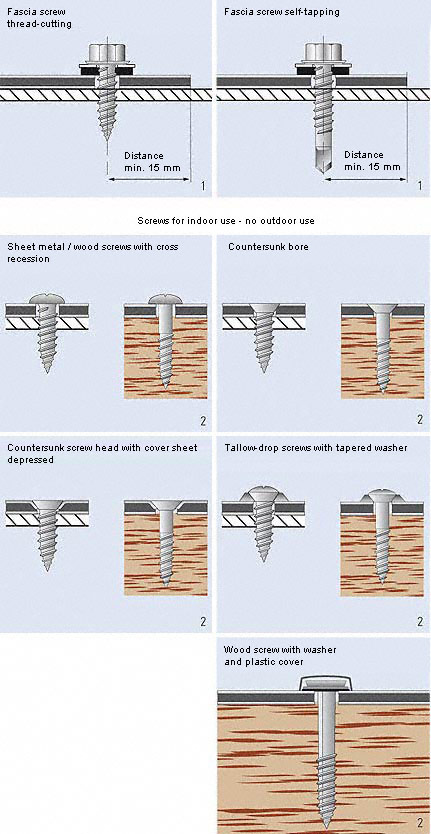Threaded fasteners for outdoor use
For outdoor use make sure to take the thermal expansion of the panel into account. To avoid jamming, the hole diameter in the
panel must allow for the expansion. Fastening without jamming is possible using fascia screws made of stainless steel with
sealing washer (Fig. 1) that have been approved for construction. The screws must be suitable for the corresponding substructure
(please note the information given by the manufacturer). The screws should be tightened with a torque wrench or screwdriver so that
the sealing washer is placed on the panel for sealing the bore hole without exerting pressure to the panel. Multi-step
drills or sleeves with corresponding diameters are used for centrically drilling holes into the panel and the substructure, and
for centrically fitting the rivet. Important: Make sure to remove the protective foil only from the screwing area prior to screwing.
Threaded fasteners for indoor use
Screws for sheet metal and wood with different head shapes can be used for indoor application (Fig. 2). They do not normally allow for any panel expansion. Countersunk screws can be inserted by the usual countersinking method or by depressing the aluminium surface into the panel. When depressing the aluminium surface, the hole diameter in the panel must be larger than the screw diameter.
Threaded fasteners for outdoor use
For outdoor use make sure to take the thermal expansion of the panel into account. To avoid jamming, the hole diameter in the panel must allow for the expansion. Fastening without jamming is possible using fascia screws made of stainless steel with sealing washer (Fig. 1) that have been approved for construction. The screws must be suitable for the corresponding substructure (please note the information given by the manufacturer). The screws should be tightened with a torque wrench or screwdriver so that the sealing washer is placed on the panel for sealing the bore hole without exerting pressure to the panel. Multi-step drills or sleeves having corresponding diameters are used for centrically drilling holes into the panel and the substructure and for centrically fitting the rivet. Important: Make sure to remove the protective foil in the screwing area prior to screwing.Threaded fasteners for indoor use
Screws for sheet metal and wood with different head-shapes are suitable for indoor use (Fig. 2). They do not normally allow for any panel expansion. Countersunk screws can be inserted by the usual countersinking method or by depressing the aluminium surface into the panel. When depressing the aluminium surface, the hole diameter in the panel must be larger than the screw diameter.